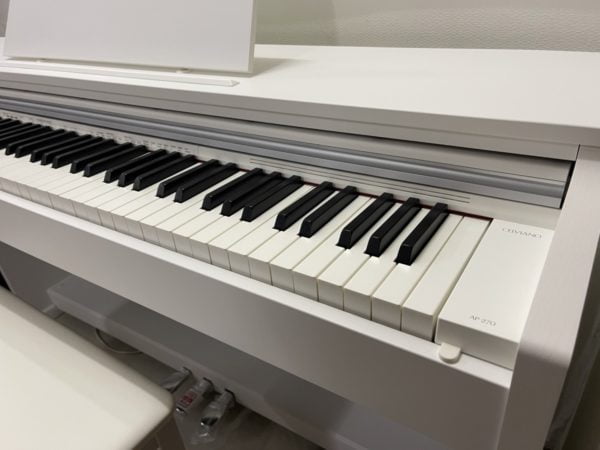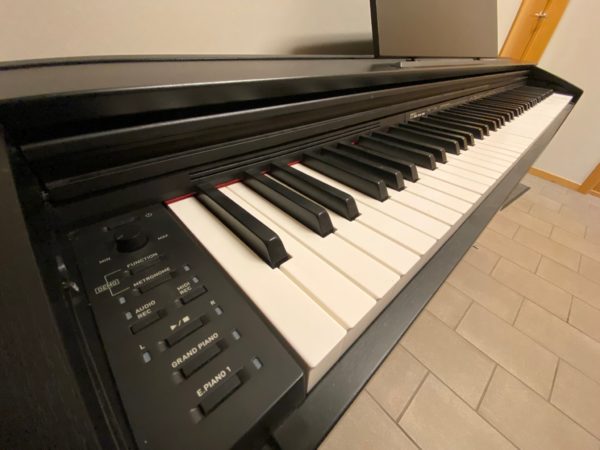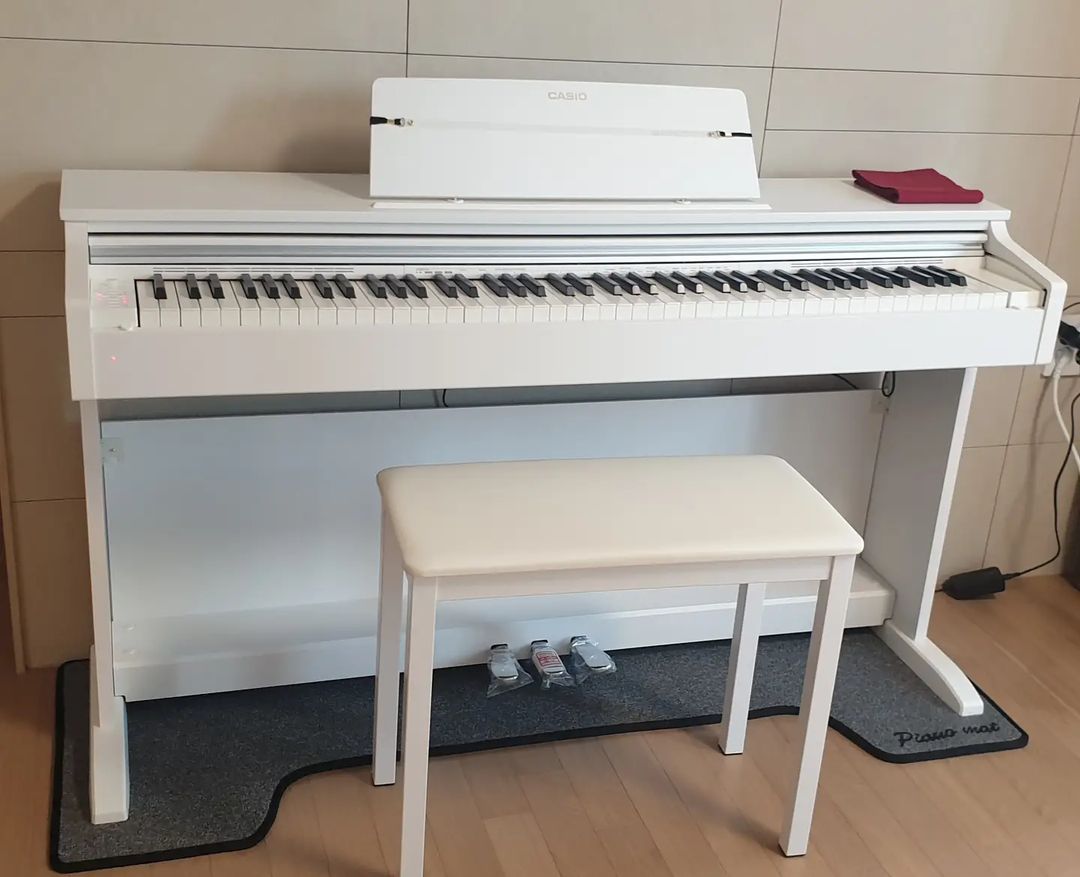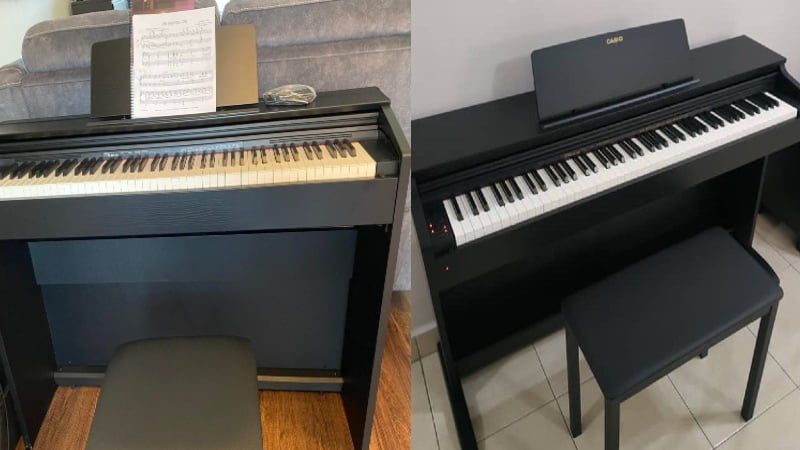Learn which digital console piano will serve you better in this Casio PX-870 vs AP-270 comparison.
When making this Casio PX-870 vs AP-270 comparison, I was very torn. Since they both offered a wide range of different features and are available at a fair price, it was really hard to determine a winner.
But after rigorous testing and research, I ended up choosing the Casio AP-270 as the winner. With that said, the AP-270 won by the narrowest of margins.
Both of the pianos are great models for beginners and novices alike. And for most of this comparison, these two pianos were tied, especially when it came down to the feel and other features.
However, the Casio AP-270 featured a slightly larger sound library, which is why I declared it the winner by the end of it all.
Casio PX-870 vs AP-270: Comparison Chart




Last update on 2025-04-22 / Affiliate links / Images from Amazon Product Advertising API
Casio PX-870 vs AP-270: The Differences
Determining the winner between these two different pianos was hard. In fact, after comparing their differences, the Casio AP-270 only won out by one point. The final score in this comparison was 3-2 in favor of the AP-270, but keep in mind, the AP-270 only won that extra point by an incredibly fine margin, which is worth considering.
Tone
The winner: Casio AP-270
The first point of comparison between these two pianos was also the deciding factor. The Casio AP-270 has a larger sound library than the Casio PX-870, which gave it a slight edge and is why I awarded it the point. If it weren’t for the sound library, these pianos would have been tied in each category.
+Tone Generation
You can expect similar tones from these two pianos. This is because they run on the AiR Sound Source. This is a signature feature of Casio pianos, especially the ones in the higher-end of their catalog.
AiR stands for Acoustic and Intelligent Resonator. This means that the pianos are loaded with top-quality, multi-layered samples. While the foundational technology behind this tone generator is still sampling, the multi-layered samples produce much more realistic piano voices.
So, regardless of whether you choose the AP-270 or the PX-870, you can expect top-quality piano tones. In fact, both of these models easily compete with any model in their price range and even some models in higher price ranges.
+Sound Library

These two were tied in terms of tone generation. However, when it came down to the sound library, the AP-270 had a very slight edge. This is because it comes with 22 different voices. This means it has three more voices than the Casio PX-870, which gives it a bit more versatility.
With that said, both of these pianos still offer a fairly wide sound library, especially compared to other digital console pianos. On both instruments, you can choose from a variety of piano, organ, strings, and even bass voices.
The only advantage of the Casio AP-270 is that you have three additional grand piano voices. This isn’t too much of a difference, but if you’re particular about the tone of your piano, these three voices can make a huge difference.
Feel
The winner: Tie
There was no separating these pianos in terms of feel. While the Celviano collection is largely seen as the more premium collection from Casio, the PX-870 is the flagship model of the Privia collection. So, from hammer action all the way down to key texture, the Casio PX-870 held its own.
+Hammer Action
One of my favorite features of both pianos was the hammer action. Both pianos use Scaled Hammer action, but the Casio PX-870 uses Scaled Hammer II. While the PX-870’s weight is a bit more realistic, the difference wasn’t too big.
With that said, both of the pianos offer a very realistic weight. Scaled Hammer Action is designed to replicate the feel of an acoustic piano. So, you can expect the lower end of the piano to have heavier keys than the higher end.
This is the same as how acoustic pianos are weighted, and adds a very realistic dimension to the pianos. Hammer action is one of the most important factors of any digital piano, which is why it’s great news that both of these pianos come with great hammer action systems.

+Key Texture
Both of these pianos have coated and textured keys. Usually, even if digital pianos have scaled hammer action, they feature glossy plastic keys. While the difference isn’t that noticeable, it makes for a very slippery and undesirable feel, which a lot of experienced pianists look to avoid.
So, to solve this, Casio coated the keys with a synthetic ebony and ivory coating. That way, the texture somewhat resembles that of an acoustic piano.
However, I have to say that these keys still feel a bit like plastic. They do feel way more realistic than regular glossy keys on more budget-friendly options, but it just would have been nice if either of these pianos featured real wooden keys.
Piano Features
The winner: Tie
Another reason these pianos were so close together in this comparison is piano features. Both pianos feature the same effects and playing modes, which made it incredibly hard for me to choose a winner between these two great pianos.
+Effects
The Casio PX-870 comes with reverb, chorus, and brilliance effects. On the flip side, the AP-270 comes with reverb, chorus, brilliance, and built-in DSP. While the AP-270 has one additional effect, it’s mostly a passive effect that only makes a small difference to the tone.
If you’re very particular about your tone, built-in DSP could be important. However, keep in mind that the AP-270 is almost $200 more expensive than the PX-870. So, before opting for the AP-270 because of the built-in DSP, you need to ask yourself if it’s worth the additional price.

+Playing Modes
Another cool feature of these two pianos are the playing modes. Both pianos feature lesson, split, and dual modes. This makes for a very versatile experience. With lesson mode, you can go through piano lessons and play duets as if you have two mini keyboards.
With split mode, you can assign different voices to the right and left side of the piano. And with dual mode, you can blend different voices to produce a unique tone with your own texture and spin.
Additionally, you can also record your playing using the piano. While the recording quality is far from studio-level, it’s great for practicing and listening back to yourself to learn areas where you did well and areas that need improvement.
Casio PX-870 vs AP-270: The Similarities
While these two pianos come from two different product lines, they do offer a lot of similarities. To start, these are both digital console pianos. So, that means they are designed to stay in one place for a long time. They aren’t portable, so they may not be ideal for people looking for a piano to bring with them to gigs, but they work well as home or venue instruments.
Additionally, both of these pianos have sophisticated hammer action systems. While I found the Casio PX-870’s hammer action more realistic, the difference was minimal.
On top of that, both pianos use the same tone generation system. This is not a complaint at all since the AiR Sound Source is one of the most sought-after tone generation systems in this price range.
While the Casio AP-270 offered more versatility and I ultimately found it the winner, keep in mind it’s significantly more expensive than the PX-870. So, if these extra features aren’t what you need, then you might be better off saving some money by buying the PX-870.
Quick Rundown of the Casio PX-870
- The AiR engine provides highly-accurate grand piano sounds with seamless dynamics for a remarkably expressive and powerful performance
- The PX-870 features a variety of 19 instrument Tones, with the ability to layer and split them as needed. Touch Response - 3 sensitivity levels, Off
- With a generous 256 notes of polyphony, you can rest assured that even the most complex performances will sound perfectly natural
- The Tri-Sensor Scaled Hammer Action II keyboard has an incredible feel and captures the dynamics of a performance with unparalleled speed and accuracy
- The powerful 40-watt, 4-speaker system is designed to envelop the listener, audience and room with rich, detailed sound
Last update on 2025-04-22 / Affiliate links / Images from Amazon Product Advertising API
Quick Rundown of the Casio AP-270
- 22 tones including two brilliant concert grand pianos, with a generous 192 notes of polyphony
- 88 fully-weighted hammer-action keys with Casio's acclaimed Tri-Sensor II design
- Traditional, elegant wooden cabinetry available in your choice of colors, with bench included
- Powerful stereo speaker system plus headphone outputs for quiet play at any time
- Class-compliant USB connects to the Casio Music Space iOS/Android app for lessons, score viewing, and more
Last update on 2025-04-22 / Affiliate links / Images from Amazon Product Advertising API
Product Videos
Related Articles to Casio Px 870
- Casio PX-870 vs PX-850: Finding the Best Privia Piano
- Casio PX-870 vs AP-470: What Makes the AP-470 Different?
- Casio PX-870 vs Casio AP-650: Which Casio Should You Get?
- Casio PX-870 Vs Yamaha YDP-163: Which Digital Piano Is The Better Option?
- Casio PX-870 Vs Yamaha YDP-143: A Look At Two Top Digital Console Pianos
- Casio PX-870 Vs Yamaha P-125: Should You Get A Portable Or Console Digital Piano?
- Casio PX-870 Vs Kawai KDP-110: The Best Digital Pianos In The Price Range?
- Casio PX-870 Vs Roland F140R: Which Is The Better Piano?
- Casio PX-870 Vs Roland FP-30: Which Piano Should You Choose?
- Casio PX-870 Vs 860: A Battle Of Two Privia Pianos
- Casio PX-870 Vs Roland RP102: Which Is The Better Console Digital Piano For Beginners?
- Casio PX-870 Vs PX-780: Which Casio Model Is Best For You?
- Casio PX-870 Vs Yamaha YDP-164: Which Is The Better Choice For Beginners?
- Casio PX-870 Vs Yamaha YDP-144: Which Is The Better Console Digital Piano?
- Casio PX-770 Vs 870: Which Casio Console Digital Piano Is Better?
Related Articles to Casio Ap 270
References:
- Casio PX-870: https://www.pianodreamers.com/casio-px870-review/
- Casio AP-270: https://fireinsidemusic.com/casio-ap-270-review/
Lulacruza is an electronic folk duo operating at the junction of the hypermodern and the ancient. Our music weaves together hypnotic female singing, South American folk instruments and electronic processing, while channeling pulsating waves from the source of creation.
Lalucruza is also a community where you can connect with other music lovers to collaborate, exchange ideas and share knowledge. A platform for who wants to learns the basics of playing piano, guitar, drum masters’ technique, etc.. is the premise of our website.
